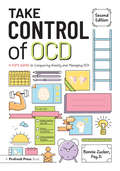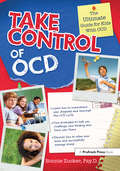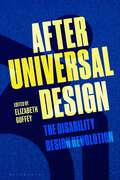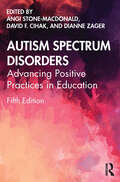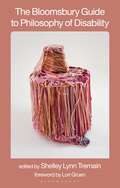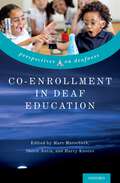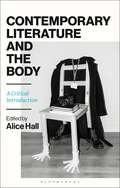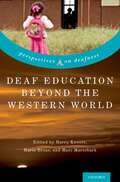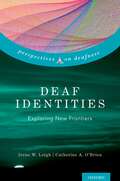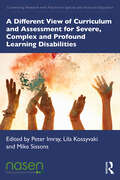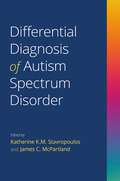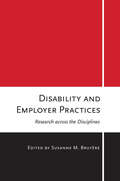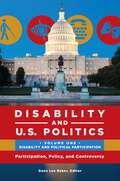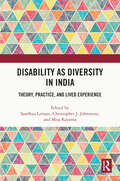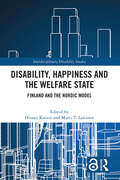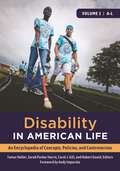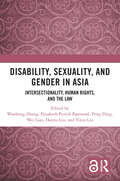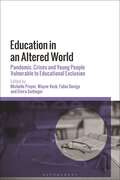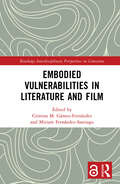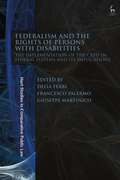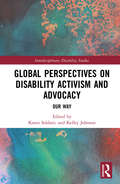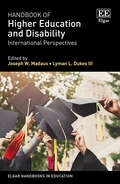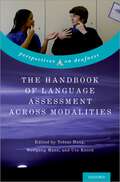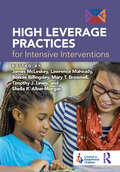- Table View
- List View
Take Control of OCD: A Kid's Guide to Conquering Anxiety and Managing OCD
by Bonnie ZuckerTake Control of OCD: A Kid's Guide to Conquering Anxiety and Managing OCD is a must-have guide for kids and teens ages 10-16 with Obsessive-Compulsive Disorder to help them take control and use their strengths to find success in school and in life. This fully updated second edition:Uses a cognitive-behavioral therapy and exposure/response prevention method to stress gradual exposure to obsessive thinking patterns.Provides a step-by-step ladder-based process to help readers conquer their fears and demolish their worries.Helps kids change their obsessive thoughts, tolerate uncertainty, and develop positive self-talk and stress management.Also helps kids advocate for their needs in school and build successful relaxation procedures.Includes workbook-style pages for readers to complete.By interviewing kids with OCD from across the country, the author offers tons of advice, information, and ideas for students, by students just like them. Readers will find themselves in this book, as it normalizes and validates the often hidden and undisclosed thoughts, urges, and images, and accompanying rituals and compulsions that so many children and teens with OCD struggle with.Ages 10-16
Take Control of OCD: The Ultimate Guide for Kids With OCD
by Bonnie ZuckerTake Control of OCD: The Ultimate Guide for Kids With OCD is a unique guide just for kids ages 10-16 with Obsessive-Compulsive Disorder to help them take control of their disorder and find success in school and in life. Using a cognitive-behavioral therapy method to stress gradual exposure to students' obsessive thinking patterns, the book takes kids step-by-step through a ladder-based process to conquer their fears and demolish their worries.Focusing on helping kids change their obsessive thoughts, tolerate uncertainty, develop positive self-talk and stress management, advocate for their needs in school, find successful relaxation procedures, and face their fears, the book includes workbook-style pages for kids to complete. By interviewing kids with OCD from across the country, the author offers tons of advice, information, and ideas for students, by students just like them. This handy guidebook is sure to help children with OCD change their behaviors and conquer their worries, discovering a sense of accomplishment and achievement.Ages 10-16
Take Control of OCD: The Ultimate Guide for Kids With OCD
by Bonnie ZuckerTake Control of OCD: The Ultimate Guide for Kids With OCD is a unique guide just for kids ages 10-16 with Obsessive-Compulsive Disorder to help them take control of their disorder and find success in school and in life. Using a cognitive-behavioral therapy method to stress gradual exposure to students' obsessive thinking patterns, the book takes kids step-by-step through a ladder-based process to conquer their fears and demolish their worries.Focusing on helping kids change their obsessive thoughts, tolerate uncertainty, develop positive self-talk and stress management, advocate for their needs in school, find successful relaxation procedures, and face their fears, the book includes workbook-style pages for kids to complete. By interviewing kids with OCD from across the country, the author offers tons of advice, information, and ideas for students, by students just like them. This handy guidebook is sure to help children with OCD change their behaviors and conquer their worries, discovering a sense of accomplishment and achievement.Ages 10-16
After Universal Design: The Disability Design Revolution
How might we develop products made with and by disabled users rather than for them? Could we change living and working spaces to make them accessible rather than designing products that "fix" disabilities? How can we grow our capabilities to make designs more “bespoke” to each individual? After Universal Design brings together scholars, practitioners, and disabled users and makers to consider these questions and to argue for the necessity of a new user-centered design. As many YouTube videos demonstrate, disabled designers are not only fulfilling the grand promises of DIY design but are also questioning what constitutes meaningful design itself. By forcing a rethink of the top-down professionalized practice of Universal Design, which has dominated thinking and practice around design for disability for decades, this book models what inclusive design and social justice can look like as activism, academic research, and everyday life practices today. With chapters, case studies, and interviews exploring questions of design and personal agency, hardware and spaces, the experiences of prosthetics' users, conventional hearing aid devices designed to suit personal style, and ways of facilitating pain self-reporting, these essays expand our understanding of what counts as design by offering alternative narratives about creativity and making. Using critical perspectives on disability, race, and gender, this book allow us to understand how design often works in the real world and challenges us to rethink ideas of "inclusion" in design.
Autism Spectrum Disorders: Advancing Positive Practices in Education
The fifth edition of Autism Spectrum Disorders: Advancing Positive Practices in Education provides readers with a comprehensive and accessible understanding of current research and evidence-based practices in autism spectrum disorders (ASD), linking research, theory, and practice. This new edition includes new chapters on trauma and co-morbidity, current trends in autism research, social media, neurodiversity, and aging in people with ASD. It also features updated content on international contexts and culturally sustaining and relevant practices. Aligned with DSM-5 diagnostic criteria, this text continues to be critical reading for students and researchers in special and inclusive education programs.
The Bloomsbury Guide to Philosophy of Disability
The Bloomsbury Guide to Philosophy of Disability is a revolutionary collection encompassing the most innovative and insurgent work in philosophy of disability. Edited and anthologized by disabled philosopher Shelley Lynn Tremain, this book challenges how disability has historically been represented and understood in philosophy: it critically undermines the detrimental assumptions that various subfields of philosophy produce; resists the institutionalized ableism of academia to which these assumptions contribute; and boldly articulates new anti-ableist, anti-sexist, anti-racist, queer, anti-capitalist, anti-carceral, and decolonial insights and perspectives that counter these assumptions. This rebellious and groundbreaking book's chapters–most of which have been written by disabled philosophers–are wide-ranging in scope and invite a broad readership. The chapters underscore the eugenic impetus at the heart of bioethics; talk back to the whiteness of work on philosophy and disability with which philosophy of disability is often conflated; and elaborate phenomenological, poststructuralist, and materialist approaches to a variety of phenomena. Topics addressed in the book include: ableism and speciesism; disability, race, and algorithms; race, disability, and reproductive technologies; disability and music; disabled and trans identities and emotions; the apparatus of addiction; and disability, race, and risk. With cutting-edge analyses and engaging prose, the authors of this guide contest the assumptions of Western disability studies through the lens of African philosophy of disability and the developing framework of crip Filipino philosophy; articulate the political and conceptual limits of common constructions of inclusion and accessibility; and foreground the practices of epistemic injustice that neurominoritized people routinely confront in philosophy and society more broadly.A crucial guide to oppositional thinking from an international, intersectional, and inclusive collection of philosophers, this book will advance the emerging field of philosophy of disability and serve as an antidote to the historical exclusion of disabled philosophers from the discipline and profession of philosophy.The Bloomsbury Guide to Philosophy of Disability is essential reading for faculty and students in philosophy, disability studies, political theory, Africana studies, Latinx studies, women's and gender studies, LGBTQ studies, and cultural studies, as well as activists, cultural workers, policymakers, and everyone else concerned with matters of social justice.Description of the book's cover: The book's title appears on two lines across the top of the cover which is a salmon tone. The names of the editor and the author of the foreword appear in white letters at the bottom of the book. The publisher's name is printed along the right side in white letters. At the centre, a vertical white rectangle is the background for a sculpture by fibre artist Judith Scott. The sculpture combines layers of shiny yarn in various colours including orange, pink, brown, and rust woven vertically on a large cylinder and horizontally around a smaller cylinder, as well as blue yarn woven around a protruding piece at the bottom of the sculpture. The sculpture seems to represent a body and head of a being sitting down, a being with one appendage, a fat person, or a little person.
Co-Enrollment in Deaf Education (Perspectives on Deafness)
Co-enrollment programming in deaf education refers to classrooms in which a critical mass of deaf and hard-of-hearing (DHH) students is included in a classroom containing mainly hearing students and which is taught by both a mainstream teacher and a teacher of the deaf. It thus offers full access to both DHH and hearing students in the classroom through "co-teaching" and avoids academic segregation of DHH students, as well as their integration into classes with hearing students without appropriate support services or modification of instructional methods and materials. Co-enrollment thus seeks to give DHH learners the best of both (mainstream and separate) educational worlds. Described as a "bright light on the educational horizon," co-enrollment programming provides unique educational opportunities and educational access for DHH learners comparable to that of their hearing peers. Co-enrollment programming shows great promise. However, research concerning co-enrollment programming for DHH learners is still in its infancy. This volume sheds light on this potentially groundbreaking method of education, providing descriptions of 14 co-enrollment programs from around the world, explaining their origins, functioning, and available outcomes. Set in the larger context of what we know and what we don't know about educating DHH learners, the volume offers readers a vision of a brighter future in deaf education for DHH children, their parents, and their communities.
Contemporary Literature and the Body: A Critical Introduction
Contemporary Literature and the Body: a Critical Introduction introduces readers to key theorists and shifting critical trends in the field from 1940 to the present and examines these in relation to close readings of texts from a range of different genres. It argues that scholarship on literature and the body is of fundamental importance to discussions about gender, race, sexuality, class, age, narrative form, and processes of reading and writing. Contemporary Literature and the Body: a Critical Introduction understands 'literature' in a broad sense: as fundamentally connected to changes in technology, culture and the environment. Offering a lively and accessible synthesis, it explores how literary writing of present and recent decades is concerned with the challenges of conveying physical experiences, experimenting with sensory perception, and thinking through the relationship between embodiment, identity and knowledge.
Deaf Education Beyond the Western World: Context, Challenges, and Prospects (Perspectives on Deafness)
If teachers want to educate deaf learners effectively, they have to apply evidence-informed methods and didactics with the needs of individual deaf students in mind. Education in general -- and education for deaf learners in particular -- is situated in broader societal contexts, where what works within the Western world may be quite different from what works beyond the Western world. By exploring practice-based and research-based evidence about deaf education in countries that largely have been left out of the international discussion thus far, this volume encourages more researchers in more countries to continue investigating the learning environment of deaf learners, based on the premise of leaving no one behind. Featuring chapters centering on 19 countries, from Africa, Asia, Latin America, and Central and Eastern Europe, the volume offers a picture of deaf education from the perspectives of local scholars and teachers who demonstrate best practices and challenges within their respective regional contexts. This volume addresses the notion of learning through the exchange of knowledge; outlines the commonalities and differences between practices and policies in educating deaf and hard-of-hearing learners; and looks ahead to the prospects for the future development of deaf education research in the context of recently adopted international legal frameworks. Stimulating academic exchange regionally and globally among scholars and teachers who are fascinated by and invested in deaf education, this volume strengthens the foundation for further improvement of education for deaf children all around the world.
Deaf Identities: Exploring New Frontiers (Perspectives on Deafness)
Over the past decade, a significant body of work on the topic of deaf identities has emerged. In this volume, Leigh and O'Brien bring together scholars from a wide range of disciplines -- anthropology, counseling, education, literary criticism, practical religion, philosophy, psychology, sociology, and deaf studies -- to examine deaf identity paradigms. In this book, contributing authors describe their perspectives on what deaf identities represent, how these identities develop, and the ways in which societal influences shape these identities. Intersectionality, examination of medical, educational, and family systems, linguistic deprivation, the role of oppressive influences, the deaf body, and positive deaf identity development, are among the topics examined in the quest to better understand deaf identities. In reflection, contributors have intertwined both scholarly and personal perspectives to animate these academic debates. The result is a book that reinforces the multiple ways in which deaf identities manifest, empowering those whose identity formation is influenced by being deaf or hard of hearing.
A Different View of Curriculum and Assessment for Severe, Complex and Profound Learning Disabilities (Connecting Research with Practice in Special and Inclusive Education)
A Different View of Curriculum and Assessment links a theoretical pedagogical model with a sympathetic practical model of curriculum and assessment difference for those with PMLD, CLD and SLD. Split into two parts, this accessible resource combines theoretical explanations with first-hand accounts of how this works in educational establishments, through the analysis of evidence-based practice carried out in a number of English special (specialist) schools. The expert authors challenge the notion that a national, or common core standards, curriculum, however expertly differentiated, is fit-for-purpose for the PMLD, CLD and SLD populations in any country. A Different View offers cogent and reasoned arguments for considering that irrespective of age, such learners learn differently to their neuro-typical, conventionally developing peers. If they learn differently, this book shows how we should be teaching them differently. Reflecting the centrality of process over product, this book will clearly explain how each individual learner might be enabled and facilitated to become the best they can be and do the best they can do, in order to fully realise their potential as equal and independent citizens.
Differential Diagnosis of Autism Spectrum Disorder
Differential Diagnosis of Autism Spectrum Disorder provides a framework for clinical considerations and best practices related to diagnosing children with autism spectrum disorder (ASD) versus commonly co-occurring conditions. Differential diagnosis is a complex process, and it is common for clinicians to observe symptom overlap between conditions. In this comprehensive text, the authors focus on the similarities and differences between ASD and a second diagnosis. Leading experts provide practical guidance in the diagnostic process for ASD versus a second condition, such as anxiety or attention deficit/hyperactivity disorder. Each chapter includes clinical case studies to provide real-world examples of how clinicians make diagnostic decisions. Ample illustrations and 'decision trees' provide a visual representation of clinical decision-making.
Disability and Employer Practices: Research across the Disciplines
This book is about the employment of people with disabilities in the United States and the important role of employer practices. Nearly one in five people report some form of disability, and they are only half as likely to be employed as those without disabilities. With the aging workforce and returning military veterans both contributing to increasing number of disabilities in the workplace, there is an urgent need for better ways to address continuing employment disparities for people with disabilities. Examining employer behaviors is critical to changing this trend. It is essential to understand the factors that motivate employers to engage this workforce and which specific practices are most effective. Disability and Employer Practices features research-based documentation of workplace policies and practices that result in the successful recruitment, retention, advancement, and inclusion of individuals with disabilities. The Cornell team whose work is featured in this book drew from multiple disciplines, data sources, and methodologies to learn where employment disparities for people with disabilities occur and to identify workplace policies and practices that might remediate them. The contributors include individuals with expertise in the fields of business, economics, education, environmental design and analysis, human resources, management, industrial/organizational psychology, public health, rehabilitation psychology, research methods, survey design, educational measurement, statistics, and vocational rehabilitation counseling.
Disability and U.S. Politics [2 volumes]: Participation, Policy, and Controversy [2 volumes]
More than 1 billion people worldwide have a disability, and they are all affected by politics. This two-volume work explores key topics at the heart of disability policy, such as voting, race, gender, age, health care, social security, transportation, abuse, and the environment.Disability policy is no longer an area that can be adequately addressed within major areas of public policy such as welfare, health, labor, and education. Disability has become widely acknowledged in recent decades, partly because of the increasing number of disabled citizens across all demographic populations. Advocates argue that diversity of all kinds deserves recognition and accommodation. This set examines policies targeting disability to provide a multifaceted description of the political participation of people with disabilities as well as disability policy development in the United States. The first volume focuses on political participation and voting issues, and the second volume covers disability public policy.In these two volumes, numerous scholars and experts in the social sciences and humanities explore timely topics that are key to disability policy questions, including activism, voting, race, gender, age, health care, social security, civil rights, abuse, the environment, and even death. Readers will better understand the challenges that policymakers face in grappling with controversies over issues of social engineering and public policy, often attempting to reconcile majority experience with minority rights. The chapters analyze the history of disability politics, describe the disability policy infrastructure as it currently exists in the United States, and provide insight into current disability-related controversies.
Disability as Diversity in India: Theory, Practice, and Lived Experience
This book critically analyses diverse experiences related to disability in India. Drawing upon intersectionality theory, it explores a range of issues regarding everyday experiences of disability in relation to gender, religion, social experiences, and India’s neoliberal economy and its built environment. From theoretical to deeply personal, this book discusses themes like invisible disability and identity; women with disabilities in India; bodily frustrations and cultural stigma; emotional stability and self-esteem of children with disabilities; neurodiversity and queerness; and overcoming the barriers. It also emphasizes the impact of the writings of women with disabilities on their personal experiences. The volume discusses perspectives and practices of schooling, curricular transactions, and inclusive education that have evolved for children who are deaf in India.Conversational and interdisciplinary, this book will be of interest to scholars and practitioners of disability studies, social care, mental health, social psychology, gender studies, social work, and special education.
Disability, Happiness and the Welfare State: Finland and the Nordic Model (Interdisciplinary Disability Studies)
This book looks at disability as an evolving social phenomenon. Disability is created through the interaction between persons with impairments and their environment.Exploring these experiences of persons with disabilities and discussing universality and particularity in our understanding of assumed development and normalcy, it takes Finland, which has been chosen repeatedly as the happiest country in the world as its case- study. Using disability as a critical lens helps to demystify Finland that has the positive reputation of a Welfare State. By identifying different kinds of discrimination against persons with disabilities as well as successful examples of disability inclusion, it shows that when looking Finland from the perspective of persons with disabilities, inequality and poverty have been collective experiences of too many of them.It will be of interest to all scholars and students of disability studies, sociology, social policy, social work, political science, health and well-being studies and Nordic studies more broadly.The Open Access version of this book, available at http://www.taylorfrancis.com, has been made available under a Creative Commons [Attribution-Non Commercial-No Derivatives (CC-BY-NC-ND)] 4.0 license.
Disability in American Life [2 volumes]: An Encyclopedia of Concepts, Policies, and Controversies [2 volumes]
Disability—as with other marginalized topics in social policy—is at risk for exclusion from social debate. This multivolume reference work provides an overview of challenges and opportunities for people with disabilities and their families at all stages of life.Once primarily thought of as a medical issue, disability is now more widely recognized as a critical issue of identity, personhood, and social justice. By discussing challenges confronting people with disabilities and their families and by collecting numerous accounts of disability experiences, this volume firmly situates disability within broader social movements, policy, and areas of marginalization, providing a critical examination into the lived experiences of people with disabilities and how disability can affect identity.A foundational introduction to disability for a wide audience—from those intimately connected with a person with a disability to those interested in the science behind disability—this collection covers all aspects of disability critical to understanding disability in the United States. Topics covered include characteristics of disability; disability concepts, models, and theories; important historical developments and milestones for people with disabilities; prominent individuals, organizations, and agencies; notable policies and services; and intersections of disability policy with other policy.
Disability, Sexuality, and Gender in Asia: Intersectionality, Human Rights, and the Law
This book introduces experiential knowledge of the intersectionality of disability, sexuality, and gender equality issues. Scholars and disabled persons’ organizations in different Asian countries such as China, Vietnam, Myanmar, Nepal, and Japan have contributed to the book. It is a preliminary introduction of the frontline practice of Asian disability activism and the experience of women and LGBTIQ people with disabilities. It presents the direct participation of disability advocates in mapping how both women with disabilities and LGBTIQ individuals with disabilities realize their rights such as identity, work rights, personal safety, and sexual rights. Studies presented here explore the experience of empowering diverse disability groups and advocating for equality and non-discrimination. It explains how to use the leverage of the Convention on the Rights of Persons with Disabilities (CRPD) for further human rights campaigns in a broader context for disadvantaged groups. This collection is the product of a participatory research project, which aims to increase the capabilities of local disabled persons’ organizations and NGOs in utilizing human rights laws and encourage dialogue and collaboration between academia, people with disabilities, and human rights advocates. It will be essential reading for academics, researchers, policy-makers, and campaign groups.
Education in an Altered World: Pandemic, Crises and Young People Vulnerable to Educational Exclusion
This book brings together world-leading researchers and scholars in the fields of inclusive education, disability studies, refugee education and special education to examine critical and original perspectives of the meaning and consequences of educational and social exclusion. Drawing together, the contributors consider how children already vulnerable to exclusion might be supported and educated in and through times of global pandemic and crisis. They also identify broad prospects for education and inclusion in, through and beyond times of global pandemic and crisis.
Embodied VulnerAbilities in Literature and Film (Routledge Interdisciplinary Perspectives on Literature)
Embodied VulnerAbilities in Literature and Film includes a collection of essays exploring the ways in which recent literary and filmic representations of vulnerability depict embodied forms of vulnerability across languages, media, genres, countries, and traditions in the late 20th and early 21st centuries. The volume gathers 12 chapters penned by scholars from Japan, the USA, Canada, and Spain which look into the representation of vulnerability in human bodies and subjectivities. Not only is the array of genres covered in this volume significant— from narrative, drama, poetry, (auto)documentary, or film— in fiction and nonfiction, but also the varied cultural and linguistic coordinates of the literary and filmic texts scrutinized—from the USA, Canada, Spain, France, the Middle East, to Japan. Readers who decide to open the cover of this volume will benefit from becoming familiar with a relatively old topic— that of vulnerability— from a new perspective, so that they can consider the great potential of this critical concept anew.
Federalism and the Rights of Persons with Disabilities: The Implementation of the CRPD in Federal Systems and Its Implications (Hart Studies in Comparative Public Law)
This book shines a light on the still unexplored relationships between federalism and disability rights. It investigates how the UN Convention on the Rights of Persons with Disabilities (CRPD) is implemented by different federal systems around the world. It analyses the effects that the obligations undertaken under the CRPD have on federal governance and on the constitutional division of powers within 14 federal systems, including those in Germany, Canada, Brazil, India, the UK and Italy. The book also considers the trends and patterns of disability rights governance in federal systems and looks at the future developments of comparative disability federalism.
Global Perspectives on Disability Activism and Advocacy: Our Way (Interdisciplinary Disability Studies)
This book explores the diverse ways in which disability activism and advocacy are experienced and practised by people with disabilities and their allies. Contributors to the book explore the very different strategies and campaigns they have used to have their demands for respect, dignity and rights heard and acted upon by their communities, by national governments and the international community. The book, with its contemporary global focus, makes a significant contribution to the field of disability and social justice studies, particularly at a time of major social, political and cultural upheaval. Global Perspectives on Disability Activism and Advocacy offers a significant intervention within the field of disability at a time of major social upheaval where actors, advocates and activists are seeking to hold onto existing claims for rights, equality and disability justice.
Handbook of Higher Education and Disability (Elgar Handbooks in Education)
This Handbook is an essential starting point for cross-national examinations, comparisons, and discussions about state-of-the-art practices in higher education accessibility and service delivery support for disabled students. Spanning a broad geographical range, the topics addressed are examined within the context of the practice and philosophy of different countries.With trends and practices varying from country to country, each topic is explored from a range of international perspectives. Structured into three distinct sections, the Handbook first addresses how students with disabilities and their families can prepare for the transition to postsecondary education, before moving to present an overview of the types of support and services available to students with disabilities. The final chapters then explore a variety of topics related to higher education and disability, including assistive technology, disability culture and social justice, emerging trends and promising practices, self-determination and universal design.This accessible Handbook will prove an invaluable reference tool for researchers, academics and students with an interest in the sociology of education from health, education and welfare policy perspectives, as well as for higher education policymakers and funding and governance bodies.
The Handbook of Language Assessment Across Modalities (Perspectives on Deafness)
Historically, research on spoken language testing dates back to the late 1920s with the majority of work starting around the time of World War II. In contrast, signed language assessment research is a young area, nested within signed language linguistics, deaf education, and applied linguistics. To this day, very few signed language tests that can be used in applied contexts are available for learners of a signed language. This volume addresses issues that are inherent to language assessment development, regardless of the modality of the language. Comprised of 36 chapters, the book takes a new approach to exploring theoretical and practical issues related to assessment of signed and spoken languages by bringing together well known experts from both fields to engage in stimulating discussions about key issues related to language assessment. Grouped around twelve topics, the volume editors present different perspectives to emphasize the points of similarity and chart a path for future interdisciplinary collaborations .
High Leverage Practices for Intensive Interventions
High Leverage Practices for Intensive Interventions provides special education teachers with descriptions and practical instructions on how to use High Leverage Practices (HLPs) to improve student outcomes. Since many students with disabilities spend their school day in inclusive general education classrooms, these intensive interventions are often delivered in separate or tier 3 settings to meet the students’ individualized needs. Each chapter focuses on a specific High Leverage Practice with explanations of its purpose and essential components, accompanied by examples for use with small groups of students or the individual student. This accessible and comprehensive guide is key for pre-service teachers in special education programs or those who provide intensive interventions with students.
